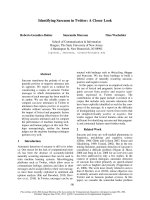Lecture Economics - Chapter 8: Behavioral economics: A closer look at decision making
Bạn đang xem bản rút gọn của tài liệu. Xem và tải ngay bản đầy đủ của tài liệu tại đây (92.82 KB, 7 trang )
Chapter 8
Behavioral Economics: A Closer Look at
Decision Making
© 2014 by McGraw-Hill Education
1
What will you learn in this chapter?
• What time inconsistency is and how it accounts
for procrastination and other problems with selfcontrol.
• Why sunk costs should not be taken into account
in deciding what to do next.
• What types of opportunity cost people often
undervalue and why undervaluing them distorts
decision making.
• What fungibility is and why it matters in financial
decision making.
© 2014 by McGraw-Hill Education
2
Scenario 1: When are sunk costs sunk?
• Suppose you buy a ticket to attend a concert
for $20. Upon arriving, your ticket is not in
your pocket. How do you react?
1. “Oh well, I’ll just buy another ticket for $20.”
2. “No way, I’m not going to spend $40 on this
concert! I’d rather go do something else instead.”
54% of people indicated they would react like 1.
46% of people indicated they would react like 2.
© 2014 by McGraw-Hill Education
3
1
Scenario 2: When are sunk costs sunk?
• Now suppose you arrive at the concert and
you are missing $20. How do you react?
1. “Oh well, I’ll just buy a ticket for $20.”
2. “You know what? Forget the concert.”
88% of people indicated they would react like 1.
12% of people indicated they would react like 2.
© 2014 by McGraw-Hill Education
4
When are sunk costs sunk?
• Scenarios 1 and 2 are identical.
– You arrive at a concert intending to see a concert.
– You have $20 less than you expected.
• If you are short on cash, it makes sense to skip the
concert.
• If you are not short on cash, why does it matter if you
lost a $20 bill before or after you’d converted it into a
concert ticket?
– This is not rational behavior.
– Emotionally, however, it seems to matter for some.
• Behavioral economics studies why individuals appear to
act irrationally by studying insights from psychology.
© 2014 by McGraw-Hill Education
5
Dealing with temptation and procrastination
• Individuals struggle against procrastination and
temptation.
• They do not complete the actions they had planned to do.
– Does this reveal preferences of valuing less the activities not
performed?
– Or, that they weren’t acting rationally?
• Individuals feel conflicted when they know they want to
do one thing, but find themselves constantly doing
another.
– Actions revealing true desires .
• These desires may go against understanding of self.
– Labelling conflicts irrational is giving up and suggests an inability
to model and predict individuals’ decisions.
© 2014 by McGraw-Hill Education
6
2
Dealing with temptation and procrastination
• The conflict between plans and actions can be
better understood using time inconsistency,
competing selves, and commitment.
• One theory on why individuals give in to
temptation is that individuals can hold two
inconsistent sets of preferences:
1. What we would like to want in the future.
2. What we will want in the future, when the future
comes.
• When individuals change their minds about what
they want simply because of the timing of the
decision, they exhibit time inconsistency.
© 2014 by McGraw-Hill Education
7
Active Learning: Time inconsistency
You have a test tomorrow. If your friends are
going to the movies now, would you go with
them and study after the movie?
© 2014 by McGraw-Hill Education
8
Time inconsistency
• Time inconsistency helps to explain behaviors like
procrastination and lack of self-control. It is as if
there are two selves inhabiting our thoughts.
– Future-oriented self: Clear-sighted preferences to get
things done.
– Present-oriented self: Backslides when faced with
alternative choices now.
• No matter how wise the decisions about the
future are that the future-oriented self makes,
when that future becomes the present, the
present-oriented self will be in charge again.
© 2014 by McGraw-Hill Education
9
3
Time inconsistency
• Individuals who are aware of their timeinconsistent preferences often seek out ways
to remove temptation.
• A commitment device can be used to help
fulfill a plan for future behavior that would
otherwise be difficult.
– Increasing the cost of engaging in certain activities.
– Blocking that activity from your choice set.
© 2014 by McGraw-Hill Education
10
Active Learning: Time inconsistency
What commitment devices can be used to assure
that you will study when the movie ends?
© 2014 by McGraw-Hill Education
11
Thinking irrationally about costs
• People weigh the trade-off between costs and
benefits to arrive at a decision.
– If the benefits of doing something are greater than the
opportunity cost, rational people are assumed to do it.
– If the benefits are smaller than the opportunity cost,
they won’t choose to do it.
• In reality, people don’t always weigh costs and
benefits rationally.
– Failing to ignore sunk costs.
– Undervaluing opportunity costs.
• This erroneous decision making is an example of
cognitive bias.
© 2014 by McGraw-Hill Education
12
4
Sunk-cost fallacy
• Many times individuals remain engaged in an
activity even though the benefit of continuing
is less than the opportunity cost, especially if a
cost was incurred to engage in the activity.
– This is referred to as the sunk-cost fallacy.
• It is hard for individuals to accept losses.
• Costs that cannot be recovered are irrelevant
to whether an individual should remain
engaged in the activity or select a new activity.
© 2014 by McGraw-Hill Education
13
Active Learning: Sunk costs
Suppose you are almost failing a class but the
deadline to drop and receive a tuition refund has
passed.
• What factors should and should not be
considered when deciding whether to drop the
class?
© 2014 by McGraw-Hill Education
14
Undervaluing opportunity cost
• When making a decision, sometimes the
alternative is not readily apparent.
• This causes individuals to overvalue the
benefits and undervalue the opportunity cost
of the not selected alternative.
• People tend to undervalue opportunity costs
when they are nonmonetary:
– Individuals’ time cost.
– Implicit cost of ownership: Overvaluing items that
are owned.
© 2014 by McGraw-Hill Education
15
5
Forgetting about fungibility
• Many individuals commit to a specific purchase by
setting money aside for that purchase.
– Using envelopes to mark money for certain purchases.
– Depositing money into separate bank accounts.
• Separating money into mental categories helps
individuals commit to buying what they thought
was right during categorization.
• However, money is fungible and thus can be easily
substituted between purchases.
– May derail individuals from staying on their budget.
© 2014 by McGraw-Hill Education
16
Forgetting about fungibility
• Forgetting that money is fungible can lead
individuals to make poor choices.
• For example, suppose that an individual has a
$2,000 credit card balance and $5,000 in the
bank.
• Net wealth is identical whether the individual pays
off the balance or not:
– With balance: $5,000 - $2,000 = $3,000.
– Without balance: $3,000.
• However, the individual pays interest when
carrying a credit card balance, but doesn’t if the
balance is paid off.
© 2014 by McGraw-Hill Education
17
Forgetting about fungibility
• Forgetting that money is fungible can also
make individuals riskier.
• For example, gamblers typically play riskier
once they win a sum of money.
– Many think that they are “playing with the house’s
money,” even though it is their own.
© 2014 by McGraw-Hill Education
18
6
Summary
• For many decisions, individuals act rationally.
• For some decisions, it appears that individuals
are not acting in what is in their best interest.
• Many of these irrationalities are due to pitfalls
in the way that humans think.
• Understanding these human tendencies can
help individuals avoid common decisionmaking pitfalls.
© 2014 by McGraw-Hill Education
19
7









